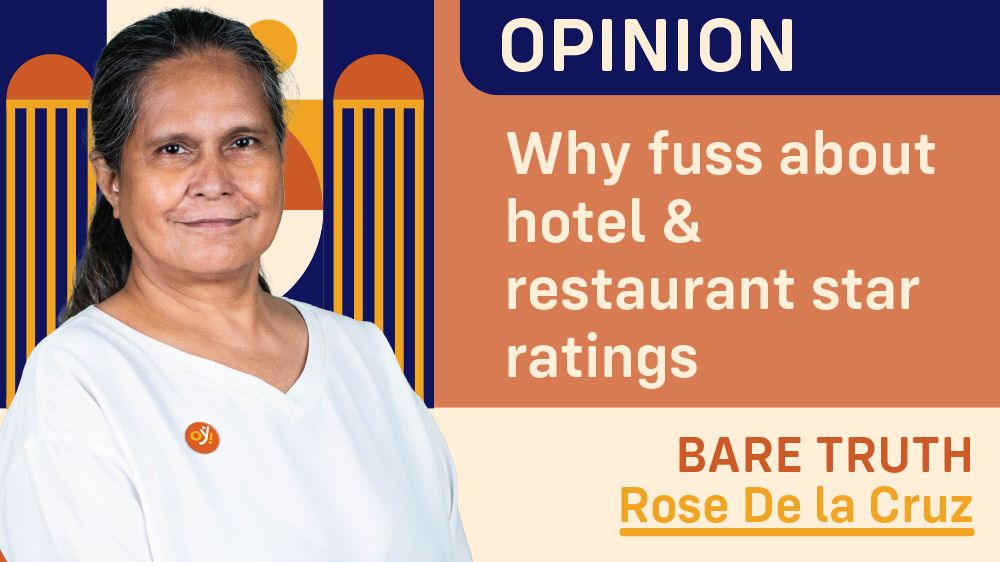I read that the Department of Tourism has released its guidelines on the star ratings for hotel and restaurants in terms of minimum requirements for star upgrading. It was said that guidelines took three years– since the time of DoT Secretary Berna Romulo Puyat (now with the Bangko Sentral ng Pilipinas) after proper consultations with the stakeholders.
The guidelines, contained in Memorandum Circular 2024-0002 signed by Tourism Secretary Ma. Christina Garcia Frasco on March 18, 2024 reflect the developments in the tourism sector over the years. The National Accreditation Standards (basically the Memo Circular) is prescribed for hotels, resorts and apartment hotels (those usually listed with the B & B). The first NAS was issued in 2012 during the term of DoT Secretary Ramon Jimenez Jr.
DOT Director for Tourism Standards and Regulations Virgilio M. Maguigad told Business Mirror that new indicators were introduced for Filipinization and Digitalization/Technology.”
He explained: “In the course of public consultations with hotel owners and operators bathtubs have already been removed as a minimum requirement because the newer hotels don’t have bathtubs anymore, and partly out of environmental concerns because it’s a waste of water.”
“Swimming pools are no longer a minimum requirement for a five-star hotel and resort but these get four additional points if one is available, or six additional points if there are properly demarcated adult and kiddie pools,” he added.
While all accommodation establishments are required by Republic Act No. 9593 (Tourism Act of 2009) to be accredited with the DOT,“the star-rating is a voluntary assessment [on the part of accommodation establishments, he explained.
Ratings are used for marketing by hotels as basis for operators to offer their services. It gives an objective assessment of a property and ensures that for instance, a five-star hotel in Davao, will have the same features or services as a five-star hotel in other parts of the country, he added.
Under the NAS, hotels, resorts, and apartment hotels will be rated anywhere from one star to five stars depending on the number of points they have garnered after going through a checklist administered by the DOT.
A one-star rating is when the establishment is scored 251-400 points, two stars (401-550), three stars (551-700), four stars (701-850), and five stars (851-1,000). A third-party assessor will be used to review new applicants, along with DOT standards staff from the headquarters and the regional office concerned.
The criteria encompass “seven dimensions” covering a hotel and resort’s arrival and departure area and services, public areas, bedroom, bathroom, F&B area, amenities and services, and business practices.
“Each dimension consists of a number of indicators, which describe either the existence or availability, quality and condition, of the facility as well as the service,” as per guidelines, which also prescribes minimum and mandatory requirements for each star level. Star ratings are valid for three years, Business Mirror noted.
In addition, a category on Service, Hospitality, Efficiency, Friendliness Requirements (SHEF) is also mandated, “which provides indicators for staff appearance, knowledge, attentiveness and service quality, applicable to all staff.”
Mandatory requirements are those “prescribed by existing laws, without which, no accreditation shall be issued to the enterprise until such time that it rectifies said deficiencies.
Minimum requirements are those basic to a certain classification, without which the establishment will not be awarded such classification but instead be downgraded to a lower classification.
Among the minimum requirements for four or five-star hotels are valet parking, concierge services, a medium mirror (31 inches x 16 inches) in public areas, minimum room size of 25 square meters, two to five suites of at least 40 sqm, comforter or duvet, three wooden clothes hanger per person, secure safety deposit box which can accommodate a 13-inch laptop, a flat-screen TV at least 32 inches with remote control, a hand and face towel, additional food and beverage outlet, and in-room dining service operating at least 12 hours, to name a few.
Maguigad underscored that properties can “appeal or dispute” the star rating issued to them within a period of time.
My take
Travel-weary guests (coming from abroad or within the traffic-plagued Metro Manila area) only look for three basic behaviors in hotel staff: 1) courtesy and a welcoming attitude; 2) friendliness and 3) genuine service, especially in big hotels, where staff is abundant, yet are hard to find. Sometimes, they would only respond without a smile as if they are there just for the pay they expect to get for their service.
Those that check into hotel rooms expect that they are escorted to their rooms with the proper card keys (so that there is no hassle of going down to the front desk for a spare card key or waiting for the room service to open the doors as they sit down on the floor in front of their rooms).
Also, the tipping habit must be stopped. Never mind the hotels in Europe or elsewhere– their living standards are way up to the roof and their staff’s salaries might be insufficient for their daily subsistence but not in the Philippines. If the tips are given freely then they must show their gratitude. But the tip should not be expected.
Some hotels have developed their own scents, but the way they spray such scents everywhere, it makes an incoming guest sneeze interminably to the point of feeling sick and nauseous.
Lastly, I commend the removal of swimming pools as a minimum requirement– though I often love to swim but not in front of hotel guests who are eating or relaxing by the poolside– for the sake of the environment. Water is now becoming scarce and in some countries has become a crisis. So why waste such a precious and finite resource on something that is barely used by people, and just serves as a prop for the most time.
#WeTakeAStand #OpinYon #OpinYonColumn #ColumnbyRoseDeLaCruz #BareTruth
